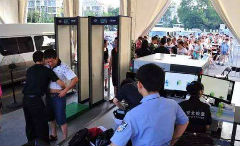Forbidden City to show more riches
2017-02-14
China Daily
As the Forbidden City opens more of the world-renowned former royal palace to the public, additional treasures will be going on display, according to Shan Jixiang, the museum’s director.
Any part of the premises “deemed suitable for opening-up will no longer be forbidden” to the public, Shan said during a lecture on Feb 12.
Shan said among the plans are the opening of a new gallery this year to display furniture used by royal families that lived in the palace. The majority of such items have not been publicly shown since 1949.
About 85 percent of the area in the museum, formally known as Palace Museum, will be made accessible to the public by 2025, according to a museum blueprint approved by the State Administration of Cultural Heritage last year. By the end of 2016, about 76 percent of the space was available.
Shan said the remaining areas will require complex restoration projects and therefore need more time to be completed.
The new gallery will showcase 2,400 sets of furniture made mostly of red sandalwood and rosewood from the museum’s collection of 6,000 sets that belonged to the Ming (1368-1644) and Qing (1644-1911) dynasties.
The gallery used to be an old warehouse for construction materials.
“Such areas need to be unlocked as exhibition space,” Shan said, adding that some 51,000 square meters of space that is currently awaiting renovation will be made available to tourists.
Another exhibition area, scheduled to be opened by the end of the year, will give the world a chance to view foundations of early Ming buildings, based on archaeological discoveries in recent years. The site dates back to the earliest days of the Forbidden City, Shan said.
The former royal complex, spread over 720,000 square meters, functioned as the seat of power in imperial China from 1420 until the end of the monarchy in 1911.
To allow visitors more viewing space, Shan said only relics restorers and security guards will continue to work within the complex’s red walls. Around 750 employees, including him, representing roughly half the staff, will move their offices out of the walled areas.
The Forbidden City’s image as a museum has grown since new measures were initiated in 2012.
Before that, it was seen as a highbrow academic institution detached from people’s daily lives, and a tourist destination where visitors marveled at the architectural grandeur but knew little about the 1.8 million sets of cultural relics housed here. Most of the doors were shut, too.
More recently, the museum has caught the fancy of China’s growing online community with its souvenirs and interactive phone apps.
In 2015, people waited overnight in lines to watch the highest profile shows of ancient calligraphy and painting in the museum’s history.
In 2016, a documentary released online and on television, titled Masters in the Forbidden City, invoked interest in the museum’s relics restorers.
“Only through more interaction and communication could the abundant cultural resources of the Palace Museum be conveyed to the public,” said Yan Hongbin, who is in charge of public education at the Forbidden City. “For many people, this museum has become a part of their everyday lives.”
On Feb 12, Shan delivered the 100th lecture of a popular series the museum has held to broaden its appeal since he took the helm in 2012.
More than 60 scholars have addressed the lectures that have been attended by 10,000 people. For the lecture on Feb 12, the original 350 entry tickets were taken within minutes of being released online.
The museum decided to reopen the online booking system and allow 100 more visitors into the auditorium. But they had to stand through the two-hour lecture.
“Such platforms offer us a chance to get together and share our knowledge and interest in history and culture,” said Pei Hong, a Beijing resident who frequently attends the lectures.


